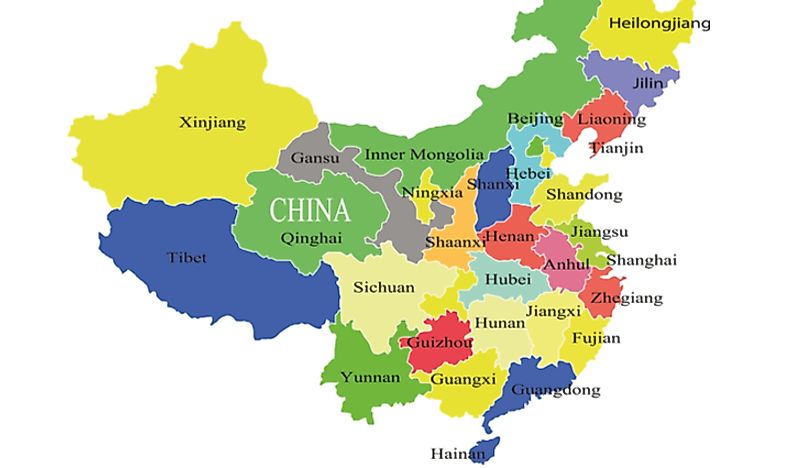Chinese Provinces By Population

China has the world's largest population of about 1.42 billion people. It is only rivaled by India (1.36 billion), and at the current growth rates, India will surpass China as the most populous country by 2030. The Chinese population may vary depending on whether the autonomous territories are included in the data or not. Taiwan claims independence although China considers it an autonomous province. Hong Kong and Macau are special administrative areas with distinct legislative, executive, and judicial systems. The following are the most populous provinces of China.
Chinese Provinces by Population
Guangdong
Guangdong is the most populous province in China with an estimated population of 111 million as of 2018. The province's population is slightly bigger than the Philippines. About 30 million individuals are considered a "floating population" consisting of immigrants, students, and laborers who are not permanent settlers. If Guangdong were an independent state, it would rank among the 20 most populous countries ahead of France, Germany, and the United Kingdom.
Shandong
Shandong is the second most populous province with a population of 100 million and the 19th largest by area covering an estimated 60,700 square miles. About 99% of the population consists of the Han Chinese while the minorities are the Manchus and the Hui. The province has the tallest population of citizens in the country with males averaging 5ft 9.4 inches and 5 ft 5 inches for females.
Henan
Henan is the third most populous province with a population of about 94 million. It is the 17th largest with an area of 64,500 square miles. If Henan were a country, it would be the 12th most populous. If the population of temporary laborers and immigrants is considered, then the population of Henan rises to about 103 million people. About 99% of the population consists of the Han while the Manchus and the Mongols are the minority.
Sichuan
Sichuan has a population of 83 million and an area of 187,700 square miles. About 95% of the population is Han Chinese while the minority are Tibetan, Qiang, Nakhi, and Yi. The population of the province is slightly larger to that of Germany. Sichuan is the agricultural basket of China, and a large percentage of the population works in the agricultural sector.
Population Control in China
The demographics of China has been a hot political issue; in the 20th century, the population grew so fast that the government introduced population control measures (one-child policy). The policy rewarded couples for having a single child with better houses, free education and healthcare, and cash bonuses. The birth rate dropped from 2.1 to about 1.4 children per woman. The policy was met with resistance especially in the rural areas as women avoided giving birth in hospitals and families lied in population censuses resulting in skewed data. The government ended the policy in 2016 after experts warned that the country was at risk of losing a generation to replace the aging population.
Chinese Provinces By Population
| Rank | Division | Population |
|---|---|---|
| 1 | Guangdong | 104,303,132 |
| 2 | Shandong | 100,063,065 |
| 3 | Henan | 94,023,567 |
| 4 | Sichuan | 80,418,200 |
| 5 | Jiangsu | 78,659,903 |
| 6 | Hebei | 71,854,202 |
| 7 | Hunan | 65,683,722 |
| 8 | Anhui | 59,500,510 |
| 9 | Hubei | 57,237,740 |
| 10 | Zhejiang | 54,426,891 |
| 11 | Guangxi[ | 46,026,629 |
| 12 | Yunnan | 45,966,239 |
| 13 | Jiangxi | 44,567,475 |
| 14 | Liaoning | 43,746,323 |
| 15 | Fujian | 36,894,216 |
| 16 | Shaanxi | 37,327,378 |
| 17 | Heilongjiang | 38,312,224 |
| 18 | Shanxi | 37,022,111 |
| 19 | Guizhou | 35,806,468 |
| 20 | Chongqing | 28,846,170 |
| 21 | Jilin | 27,462,297 |
| 22 | Gansu | 25,575,254 |
| 23 | Inner Mongolia | 24,706,321 |
| 24 | Xinjiang | 21,813,334 |
| 25 | Shanghai | 23,019,148 |
| 26 | Beijing | 19,612,368 |
| 27 | Tianjin | 12,938,224 |
| 28 | Hainan | 9,261,518 |
| 29 | Hong Kong | 7,061,200 |
| 30 | Ningxia | 6,176,900 |
| 31 | Qinghai | 5,626,722 |
| 32 | Tibet | 3,002,166 |
| 33 | Macau | 552,503 |







